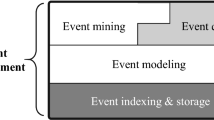Abstract
This paper presents an approach for modeling semantics associated with occurrents in geospatial domains. Occurrents correspond to what is commonly thought of as a happening or activity in the real world. We describe a modeling approach where representations of occurrents are modeled as classes of events. Additional semantics are gained by modeling specialized subclasses of event classes as derived events. Significant occurrents are modeled as noteworthy events, i.e., happenings or activities in a domain that require intervention, for example, an automated notification that a noteworthy event has been detected. The representation is extended to treat event sequences that capture a variety of occurrent-based semantics, modeling both routine and unexpected occurrents as experienced, for example, by moving entities, such as vessels in a harbor.
Preview
Unable to display preview. Download preview PDF.
Similar content being viewed by others
References
Worboys, M.: A unified model of spatial and temporal information. Computer Journal 37, 26–34 (1994)
Hornsby, K., Egenhofer, M.: Identity-based change: A foundation for spatio-temporal knowledge representation. International Journal of Geographical Information Science 14, 204–207 (2000)
Peuquet, D.: Representations of Space and Time. Guilford, New York (2002)
Galton, A.: Desiderata for a spatio-temporal geo-ontology. In: Kuhn, W., Worboys, M.F., Timpf, S. (eds.) COSIT 2003. LNCS, vol. 2825, pp. 1–12. Springer, Heidelberg (2003)
Grenon, P., Smith, B.: SNAP and SPAN: Towards dynamic spatial ontology. Journal of Spatial Cognition and Computation 4, 69–104 (2004)
Bittner, T., Donnelly, M., Smith, B.: Endurants and perdurants in directly depicting ontologies. AI Communications 17, 247–258 (2004)
Snodgrass, R. (ed.): The TSQL2 Temporal Query Language. Kluwer Academic Publishers, Dordrecht (1995)
Abraham, T., Roddick, J.: Survey of spatio-temporal databases. GeoInformatica 3, 61–99 (1999)
Yuan, M.: Representing complex geographic phenomena in GIS. Cartography and Geographic Information Science 28, 83–96 (2001)
Worboys, M.: Modeling changes and events in dynamic spatial systems with reference to socio-economic units. In: Frank, A., Raper, J., Cheylan, J. (eds.) Life and Motion of Socio-Economic Units, vol. 8, pp. 129–138. MacMillan, New Zealand (2001)
Pfoser, D., Jensen, C., Theodoridis, Y.: Novel approaches in query processing for moving object trajectories. In: Proceedings of the 26th International Conference on Very Large Data Bases, pp. 395–406. Morgan Kaufmann Publishers Inc., Cairo (2002)
Song, Z., Roussopoulos, N.: K-Nearest neighbor search for moving query point. In: Proceedings of the 7th Intl. Symposium on Advances in Spatial and Temporal Databases, pp. 79–96. Springer, Heidelberg (2001)
Papadias, P., Tao, Y., Kalnis, P., Zhang, J.: Indexing spatio-temporal data warehouses. In: 18th International Conference on Data Engineering, pp. 166–175. IEEE Computer Society, San Jose (2002)
Worboys, M.: Event-oriented approaches to geographic phenomena. International Journal of Geographical Information Science 19, 1–28 (2005)
Worboys, M., Hornsby, K.: From objects to events: GEM, the geospatial event model. In: Egenhofer, M.J., Freksa, C., Miller, H.J. (eds.) GIScience 2004. LNCS, vol. 3234, pp. 327–344. Springer, Heidelberg (2004)
Galton, A.: Fields and objects in space, time, and space-time. Journal of Spatial Cognition and Computation 4, 39–68 (2004)
Hornsby, K., Egenhofer, M.: Modeling moving objects over multiple granularities. In: Annals of Mathematics and Artificial Intelligence, vol. 36, pp. 177–194. Kluwer Academic Press, Dordrecht (2002)
Wolfson, O.: Moving objects information management: The database challenge. In: Halevy, A.Y., Gal, A. (eds.) NGITS 2002. LNCS, vol. 2382, pp. 75–89. Springer, Heidelberg (2002)
Xie, R., Shibasaki, R.: A unified spatio-temporal schema for representing and querying moving features. SIGMOD Record 34, 45–50 (2005)
Dayal, U., Buchmann, A., McCarthy, D.: Rules are objects too: A knowledge model for an active, object-oriented database system. In: Dittrich, K.R. (ed.) OODBS 1988. LNCS, vol. 334, pp. 129–143. Springer, Heidelberg (1988)
Carzaniga, A., Rosenblum, D., Wolf, A.: Achieving scalability and expressiveness in an internet-scale event notification service. In: Proceedings of the 19thAnnual ACM Symposium on Principles of Distributed Computing (PODC 2000), Portland, OR, pp. 219–227. ACM Press, New York (2002)
Hinze, A., Voisard, A.: A flexible parameter-dependent algebra for event notification services. Technical Report Number tr-b-02-10, Freie Universitat Berlin, pp. 1-17 (2002)
USCG Universal shipborne automatic identification system transponder. United States Coast Guard (2003), http://www.navcen.uscg.gov/marcomms/ais.htm (2005)
Galton, A.: Qualitative Spatial Change. Oxford University Press, Oxford (2000)
Author information
Authors and Affiliations
Editor information
Editors and Affiliations
Rights and permissions
Copyright information
© 2005 Springer-Verlag Berlin Heidelberg
About this paper
Cite this paper
Cole, S., Hornsby, K. (2005). Modeling Noteworthy Events in a Geospatial Domain. In: Rodríguez, M.A., Cruz, I., Levashkin, S., Egenhofer, M.J. (eds) GeoSpatial Semantics. GeoS 2005. Lecture Notes in Computer Science, vol 3799. Springer, Berlin, Heidelberg. https://doi.org/10.1007/11586180_6
Download citation
DOI: https://doi.org/10.1007/11586180_6
Publisher Name: Springer, Berlin, Heidelberg
Print ISBN: 978-3-540-30288-9
Online ISBN: 978-3-540-32283-2
eBook Packages: Computer ScienceComputer Science (R0)




